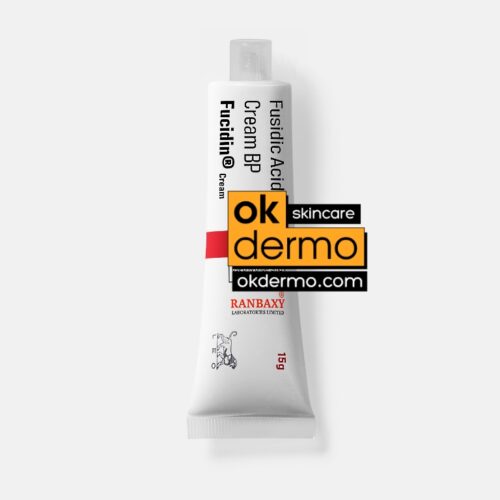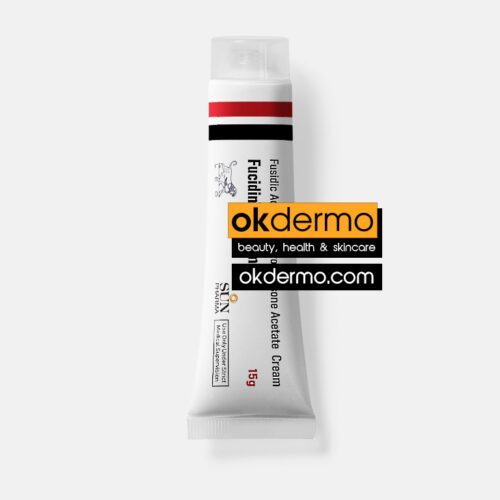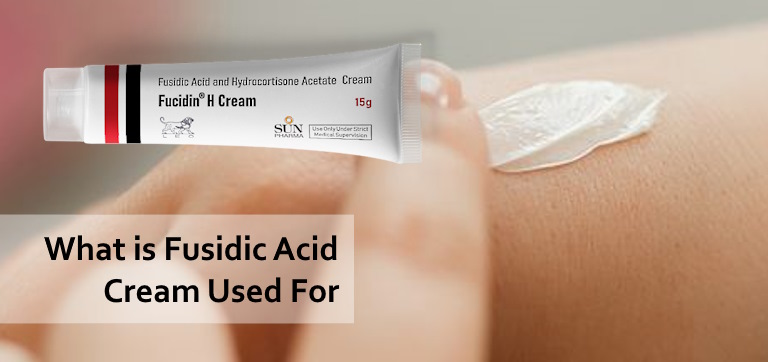What is Fusidic Acid Cream Used For
Table of Contents
Fusidic Acid Cream, commonly known as Fucidin Cream, is a topical medication utilized primarily for the treatment of bacterial skin infections. It contains fusidic acid as its active ingredient, which exerts its therapeutic effect by inhibiting bacterial protein synthesis. Fusidic Acid Cream IP is commonly prescribed due to its broad-spectrum antibacterial activity against various gram-positive bacteria, including Staphylococcus aureus.
In this guide, a comprehensive overview of Fusidic Acid Cream is offered, including its therapeutic indications and what is fusidic acid cream used for, fusidic acid cream contraindications, fusidic acid cream side effects, fusidic acid cream for wounds, fusidic acid cream for acne, fusidic acid cream for baby and more.
What is Fusidic Acid Cream?
Fusidic Acid Cream, commonly marketed under the brand name Fucidin Cream, is a topical medication utilized in the management of bacterial skin infections. It contains fusidic acid as its primary active ingredient. Fusidic acid, a naturally occurring antibiotic derived from the fungus Fusidium coccineum, serves as the basis of its pharmacological action.
The mechanism of action of Fusidic Acid Cream involves its ability to interfere with bacterial protein synthesis. Specifically, fusidic acid binds reversibly to elongation factor G (EF-G) within the bacterial ribosome, thereby inhibiting the translocation step of protein synthesis. This disruption impairs the ability of bacteria to produce essential proteins necessary for their survival and proliferation. Importantly, Fusidic Acid Cream IP exhibits selective activity against gram-positive bacteria, including strains of Staphylococcus aureus, the causative agent of various skin infections.
-

Fucidin® Fusidic Acid Cream / Ointment
Sodium Fusidate / Fusidic Acid 2%
Size: 30g / 1.06oz
USD $34.00 Select options -

Fucidin-H® Hydrocortisone Infection Treatment Cream
Hydrocortisone Acetate 1% + Fusidic Acid 2%
Size: 15g / 0.53oz
USD $21.00 Add to cart
What is Fusidic Acid Cream Used For?
Fusidic Acid Cream IP is widely utilized in dermatology for its diverse applications in treating various skin conditions.
Fusidic Acid Cream for Acne:
Fucidin Cream is effective in managing acne, a common skin condition characterized by the presence of pimples, blackheads, and whiteheads. Its antibacterial properties target Propionibacterium acnes, a bacterium associated with acne development. By reducing bacterial colonization and inflammation, Fucidin Cream helps alleviate acne symptoms and prevent lesion formation.
Fusidic Acid Cream for Wounds:
Fucidin Cream plays a crucial role in wound care, particularly for minor cuts, scrapes, and abrasions susceptible to bacterial infection. Its application promotes wound healing by preventing bacterial proliferation and reducing the risk of infection-related complications. Fucidin Cream creates an optimal environment for tissue repair, aiding in faster recovery and minimizing scarring.
Treatment of Various Skin Conditions:
When it comes to the question what skin infections does fucidin treat, the uses are extensive. It primarily targets gram-positive bacteria, including Staphylococcus aureus, Streptococcus pyogenes, and Corynebacterium species.
Primary Indications for Fucidin
- Impetigo Treatment: Fucidin is highly effective in treating impetigo, a contagious bacterial skin infection characterized by red sores that rupture and develop honey-colored crusts. Fusidic acid’s inhibition of bacterial protein synthesis eradicates causative bacteria, promoting healing and preventing spread.
- Management of Infected Eczema: Fucidin therapy is beneficial for infected eczema, a condition marked by inflamed, itchy, and infected skin patches. Bacterial superinfection commonly complicates eczema, necessitating topical antibiotics like Fucidin. By targeting bacterial pathogens exacerbating eczema symptoms, Fucidin alleviates inflammation and improves skin healing.
Utility in Treating Other Bacterial Skin Infections
- Folliculitis and Furunculosis: Fucidin is effective against folliculitis and furunculosis, two bacterial skin infections affecting hair follicles. Its localized application ensures targeted therapy, eradicating bacteria at infection sites while minimizing systemic exposure and side effects.
Is Fucidin Cream Used for Fungal Infections?
While primarily indicated for bacterial infections, occasionally is Fucidin Cream used for fungal infections as it may complement antifungal therapy in cases of fungal infections with secondary bacterial involvement. However, it is not typically used as a standalone treatment for primary fungal infections.
Suitability of Fusidic Acid Cream for Baby:
Fusidic Acid Cream for baby and pediatric populations for the treatment of bacterial skin infections is considered safe. Its localized application and minimal systemic absorption make it suitable for addressing conditions such as diaper rash and impetigo in infants. However, healthcare providers should exercise caution and adhere to prescribed dosages when using Fucidin Cream in babies.
How to Apply Fucidin Cream?
Proper application of Fucidin Cream is essential to ensure its efficacy and maximize treatment outcomes.
Guidelines for Proper Application:
- Clean and Dry Skin: Before applying Fucidin Cream, ensure that the affected area is clean and dry. Gently wash the area with mild soap and water, then pat dry with a clean towel.
- Thin Layer Application: Apply a thin layer of Fucidin Cream to the affected area(s) of the skin. Avoid excessive application, as this may lead to increased systemic absorption and potential adverse effects.
- Gentle Rubbing: After applying Fucidin Cream, gently rub it into the skin until it is absorbed. Avoid excessive rubbing or massaging, as this may irritate the skin or exacerbate existing lesions.
- Avoiding Contact with Eyes and Mucous Membranes: Exercise caution to prevent Fucidin Cream from coming into contact with the eyes, mouth, or other mucous membranes. If accidental contact occurs, rinse thoroughly with water and seek medical advice if irritation persists.
- Frequency of Application: Follow the prescribed frequency of application as directed by your healthcare provider. Typically, Fucidin Cream is applied two to three times daily, depending on the severity of the condition being treated.
Skipping doses or discontinuing treatment prematurely may result in incomplete eradication of bacterial infection and potential recurrence. Additionally, proper adherence to treatment guidelines helps minimize the risk of antibiotic resistance by ensuring adequate bacterial eradication and preventing the proliferation of resistant bacterial strains.
Fucidin Cream on Face
When considering the use of Fucidin Cream on face, several important considerations regarding its application, potential benefits, and associated risks should be taken into account.
Considerations for Using Fucidin Cream on Face:
- Sensitive Facial Skin: Facial skin is often more sensitive than skin on other parts of the body. Therefore, caution should be exercised when applying Fucidin Cream to the face to minimize the risk of irritation or adverse reactions.
- Avoiding Contact with Eyes and Mucous Membranes: Care should be taken to avoid contact between Fucidin Cream and the eyes, mouth, or other mucous membranes of the face. Accidental contact may result in irritation or discomfort and should be promptly addressed by rinsing with water.
Potential Benefits of Using Fucidin Cream on Face:
- Treatment of Facial Bacterial Infections: Fucidin Cream can be beneficial for the treatment of bacterial infections affecting the facial skin, such as impetigo or folliculitis. Its antibacterial properties help eradicate the causative pathogens, promoting healing and resolution of the infection.
- Reduction of Inflammation: In addition to its antibacterial effects, Fucidin Cream may help reduce inflammation associated with certain skin conditions, such as acne or infected eczema. By alleviating inflammation, Fucidin Cream can contribute to improved skin health and appearance.
Potential Risks of Using Fucidin Cream on Face:
- Skin Irritation: Facial skin may be more prone to irritation or sensitivity, particularly when using topical medications. While Fucidin Cream is generally well-tolerated, some individuals may experience mild irritation or redness at the application site. Discontinuation of treatment or consultation with a healthcare provider may be necessary if irritation persists or worsens.
- Risk of Fusidic Acid Cream Side Effects Near Eyes and Mouth: Care should be taken to prevent Fucidin Cream from coming into contact with the eyes, mouth, or other sensitive areas of the face. Accidental exposure may lead to discomfort, stinging, or other adverse reactions and should be avoided.

Fusidic Acid Cream Side Effects
While generally well-tolerated, fusidic acid cream side effects maybe there, particularly with prolonged or inappropriate use.
Potential Fusidic Acid Cream Side Effects:
- Skin Irritation: Common side effects of Fusidic Acid Cream IP include mild skin irritation, erythema, itching, or burning sensation at the application site. These reactions are usually transient and resolve upon discontinuation of treatment or with symptomatic management.
- Allergic Dermatitis: Hypersensitive individuals may experience allergic dermatitis characterized by localized or generalized erythema, swelling, itching, or blistering upon application of Fusidic Acid Cream. Prompt recognition and discontinuation of treatment are necessary to prevent further exacerbation of allergic reactions.
- Systemic Effects: Although Fusidic Acid Cream is topically applied, systemic absorption may occur, leading to rare systemic adverse effects such as gastrointestinal disturbances or hepatotoxicity. Patients should be monitored for signs of systemic toxicity, and treatment should be discontinued if necessary.
Frequently Asked Questions (FAQs) about Fucidin Cream
What Is the Difference Between Fucidin and Fucidin H Cream?
Fucidin and Fucidin H cream differ primarily in their composition and intended use. Fucidin cream contains fusidic acid as its active ingredient, an antibiotic effective against gram-positive bacteria like Staphylococcus aureus. It is primarily used for treating bacterial skin infections. On the other hand, Fucidin H cream combines fusidic acid with hydrocortisone acetate, a corticosteroid that provides anti-inflammatory and anti-itch properties. This combination makes Fucidin H suitable for inflammatory skin conditions where bacterial infection coexists with inflammation and itching.
While Fucidin cream focuses solely on eradicating bacterial infections, Fucidin H cream addresses both bacterial infection and inflammation. This makes Fucidin H cream preferable for conditions where inflammation is a significant component alongside bacterial infection.
What Skin Infections Does Fucidin Treat?
Fucidin is effective in treating various bacterial skin infections. It targets gram-positive bacteria, including strains of Staphylococcus aureus, Streptococcus pyogenes, and Corynebacterium species. Common skin infections treated by Fucidin include impetigo, infected eczema, folliculitis, and furunculosis. Its antibacterial properties aid in eradicating the causative bacteria, promoting lesion resolution, and preventing further spread of the infection.
What Is Fusidic Acid Cream Good For?
Fusidic acid cream has a wide range of applications in dermatology. It is particularly effective in managing bacterial skin infections, thanks to its potent antibacterial properties. Fucidin cream is commonly used to treat conditions such as impetigo, infected eczema, folliculitis, and minor wound infections. Its localized application allows for targeted therapy, effectively addressing bacterial pathogens while minimizing systemic exposure and potential side effects.
When Should You Not Use Fucidin?
There are certain situations in which the use of Fucidin should be avoided:
- Hypersensitivity: Individuals with a known hypersensitivity to fusidic acid or any of the excipients present in Fucidin cream should refrain from using it. Hypersensitivity reactions may manifest as allergic dermatitis, erythema, swelling, or pruritus upon application.
- Allergic History: Patients with a history of allergic reactions to antibiotics belonging to the fusidic acid class should exercise caution when considering Fucidin cream. Previous allergic responses raise the risk of cross-reactivity and may lead to severe allergic reactions.
- Viral Infections: Fucidin cream should not be applied to areas of skin affected by viral infections such as herpes simplex virus (HSV) or varicella-zoster virus (VZV). Using Fucidin cream on viral lesions may exacerbate viral infections or delay lesion healing.
When Do You Apply Fucidin Cream?
Typically, Fucidin cream is applied two to three times daily, depending on the severity of the condition being treated.
References:
- https://onlinelibrary.wiley.com/doi/abs/10.1046/j.1365-2133.1998.1390s3037.x
- https://www.sciencedirect.com/science/article/abs/pii/S0924857998000740
- https://academic.oup.com/jac/article-abstract/25/suppl_B/1/867395
- https://onlinelibrary.wiley.com/doi/abs/10.1111/j.1365-2230.1997.tb01070.x
- https://web.archive.org/web/20130512125140id_/http://www.nmcth.edu:80/images/gallery/Editorial/5FDMegbn_pradhan.pdf
- https://openurl.ebsco.com/EPDB%3Agcd%3A5%3A1235189/detailv2?sid=ebsco%3Aplink%3Ascholar&id=ebsco%3Agcd%3A30034443&crl=c
- https://academic.oup.com/jac/article-abstract/25/suppl_B/1/867395
- https://openurl.ebsco.com/EPDB%3Agcd%3A4%3A1235188/detailv2?sid=ebsco%3Aplink%3Ascholar&id=ebsco%3Agcd%3A30034442&crl=c
- https://www.sciencedirect.com/science/article/abs/pii/S0924857998000685
Post by:
Dr.Marcella Jiovanni
Health and Beauty Expert
“Marcella Jiovanni actively promotes the importance of maintaining healthy skin, she envisions the future of dermatology as moving away from pure medical, pharmacological dermatology and flowing more toward a holistic approach to wellness and skincare.”

















